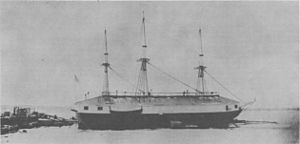Koszta Affair facts for kids
Quick facts for kids Koszta Affair |
|||||||
|---|---|---|---|---|---|---|---|
| Part of Hungarian Revolution of 1848 | |||||||
 USS St. Louis, the sloop used by Captain Ingraham to threaten the Austrian brig Huszár. |
|||||||
|
|||||||
| Belligerents | |||||||
| Commanders and leaders | |||||||
| Captain Duncan Ingraham | Unknown | ||||||
| Strength | |||||||
| 1 sloop-of-war | 1 brig-of-war | ||||||
The Koszta Affair was a big disagreement between the United States and the Austrian Empire in 1853. It was all about what rights people had who were becoming American citizens but weren't fully citizens yet, especially when they were in other countries.
Contents
The Story of Martin Koszta
Martin Koszta was born in Hungary. He took part in a movement in 1848-1849 that wanted to make Hungary independent from the Austrian Empire. Because of this, he had to leave his home country.
He first went to Turkey. Later, he moved to the United States. In July 1852, Martin Koszta officially declared that he wanted to become a citizen of the United States. He also said he would no longer be loyal to any other country.
How Koszta Was Captured
After living in the United States for almost two years, Koszta went back to Turkey for some personal business. While he was there, American officials protected him. This included the American consul in Smyrna and another American diplomat in Constantinople.
However, while waiting to return to the United States, Austrian officers captured Koszta. They took him by force onto an Austrian warship called the Huszár. He was put in chains on the ship. American officials tried to protest to the Turkish government and the Austrian officers, but it didn't work.
America Steps In
Americans heard rumors that Koszta was going to be secretly taken to a place called Trieste. This made them very worried.
The American Minister in Constantinople gave instructions to Captain Duncan Ingraham. Captain Ingraham was in charge of the American warship Saint Louis. His ship was in Smyrna harbor at the time.
On July 2, 1853, Captain Ingraham took action. He threatened to fire his ship's cannons at the Austrian ship Huszár. He said he would do this if Koszta was not given to him by four o'clock that day.
Because of Captain Ingraham's strong stand, the Austrian consul general agreed to a compromise. Koszta was released from the Austrian ship. He was then held by the consul general of France until the United States and Austria could reach a final agreement.
The Diplomatic Battle
After this event, the Austrian diplomat in Washington, Baron Hülsemann, wrote to the American Secretary of State, William L. Marcy. He demanded that the United States apologize for what its officers did. He also said that Koszta was still an Austrian citizen and that Captain Ingraham's threat was against international law.
Secretary Marcy wrote back on September 26, 1853. His letter is now famous and is called the Hülsemann letter. He strongly defended the United States' actions. He explained that Koszta was considered an American citizen when he was captured. Therefore, the United States had every right to protect him.
Marcy's letter said that international law supported the United States. He stated that Austria had no right to stop the U.S. from freeing Koszta. He also said that Captain Ingraham's actions were completely right given the unusual situation.
This letter was shared widely and was very popular in the United States. Many experts on international law have agreed with the American government's position on protecting immigrants who are becoming citizens.
The Outcome
In the end, Austria released Martin Koszta. He was allowed to return to the United States. The United States Congress recognized Captain Ingraham for his brave actions. They passed a special resolution thanking him and gave him the Congressional Gold Medal. This medal honored his important service in the Koszta Affair.

